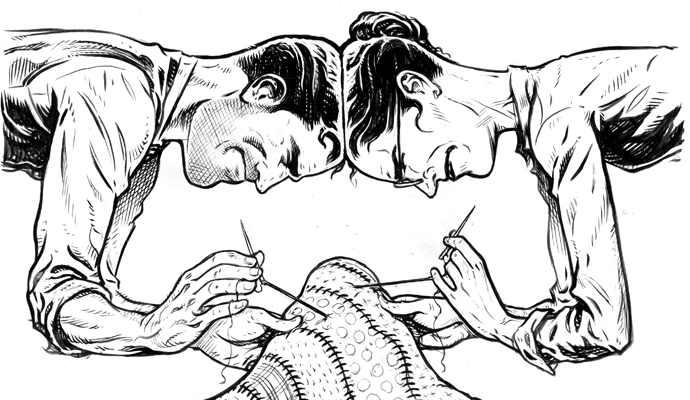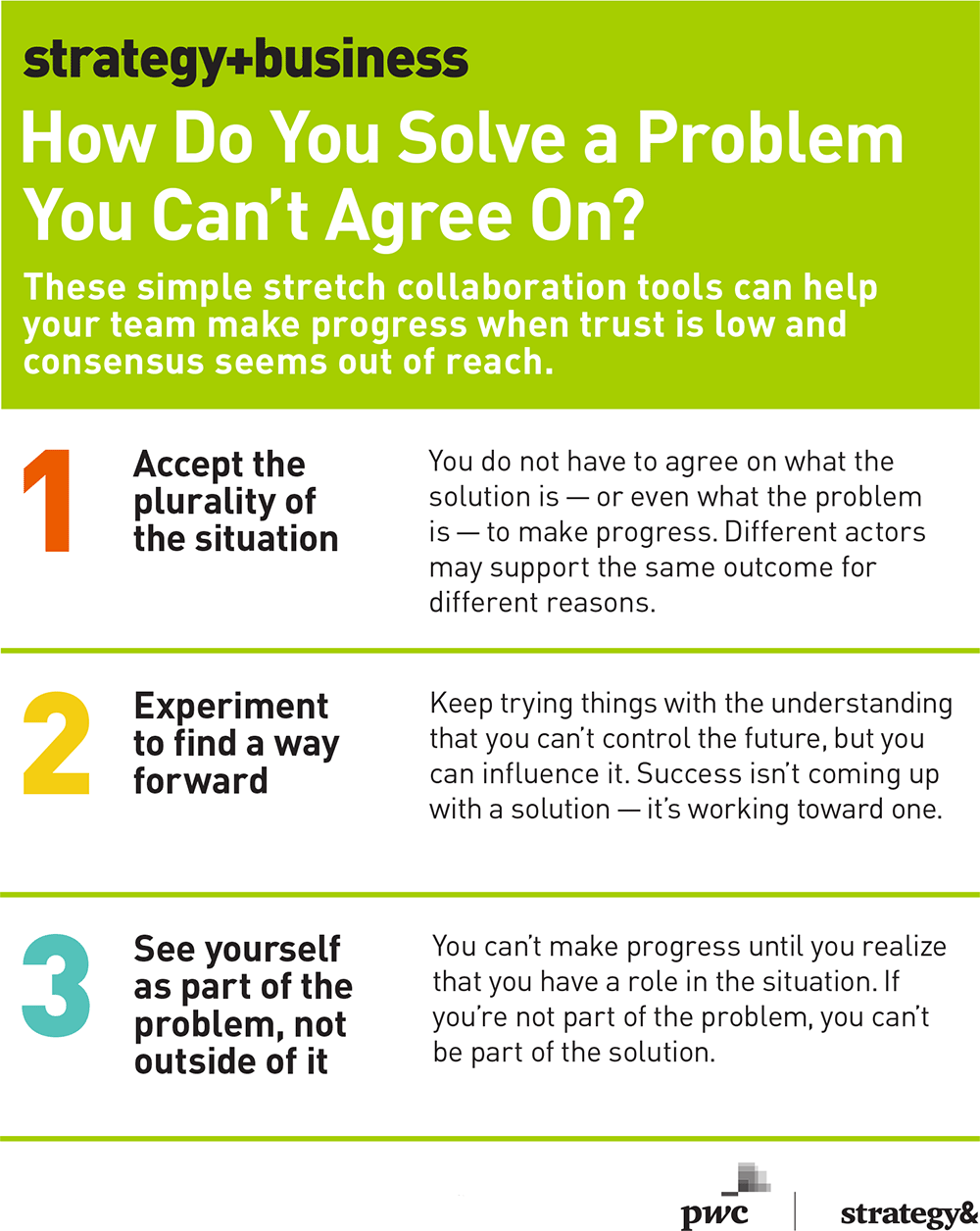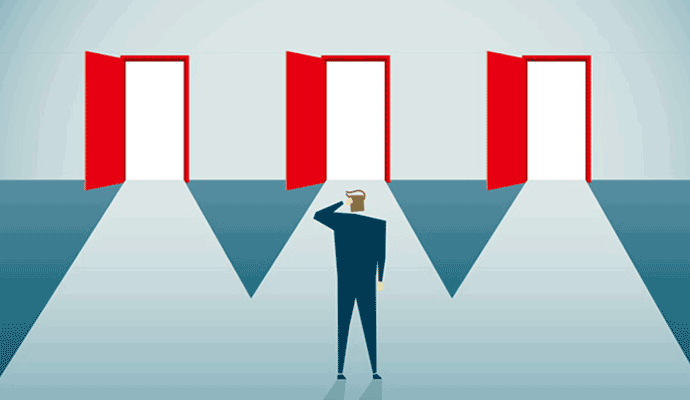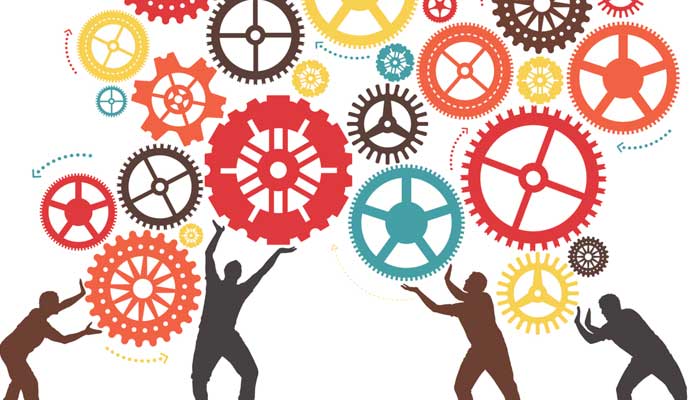How to collaborate when you don’t have consensus
Three “stretch” strategies can help teams move forward when members can’t agree and don’t like or trust one another.
A version of this article appeared in the Autumn 2018 issue of strategy+business.
Note: Parts of this column are excerpted from Adam Kahane’s books, including Collaborating with the Enemy and Solving Tough Problems.
On a rainy afternoon in 2016, I was leading a workshop to advance local development in Colombia; the meeting was one result of new peace accords that had ended 52 years of civil war. The atmosphere was tense and alert, as you might expect when leaders who bitterly opposed one another have gathered to work on their most crucial and difficult mutual problems. They were there because they knew that if they didn’t find a way to work together, the reconciliation and growth the country desperately needed might never take place.
“Haven’t I seen you somewhere?” a former guerrilla commander asked a woman sitting near me.
“Yes,” she said. “I gave you money to ransom my kidnapped daughter.”
Most business confrontations aren’t this dramatic. But lessons from extreme cases can be useful in more ordinary situations. Maybe you wouldn’t use the term enemies to describe the difficult people you need to collaborate with, but you might not agree with, like, or trust them. Circumstances might be veering out of control, and conflicts might be seemingly unresolvable. How do you move forward in situations like these?
The conventional model of collaboration in business is to go to a lot of meetings to try to get agreement on five things:
- What is our common purpose?
- What is the problem?
- What is the solution to the problem?
- What is the plan to execute the solution?
- Who needs to do what to execute the plan?
Answering these questions typically involves a delicate dance of managerial authority and employee adaptation. A boss may have a solution in mind, but could face potential downsides by enforcing it unilaterally. Those who disagree may drag their feet in implementing the plan or otherwise sabotage the team’s efforts. So instead, teams collaborate: A boss leads everyone to see the problem the same way (probably the way the boss does), and then to agree on a way forward.
But what if the people in the room are working at cross-purposes? What if they can’t even agree on what the problem is, much less how to solve it? What if there is low trust among them and no one who can control the situation? What if the only thing people can agree on is that the situation is unacceptable and must be changed?
Those were the circumstances at the workshop in Colombia, as in many other complex and conflicted situations, in politics and business. When people have fundamental disagreements, they can’t articulate their mutual interests harmoniously. Getting them to agree isn’t a realistic option. Only a few choices are available. You can try to force the issue (and face the repercussions of a backlash); you can try to adapt to the unacceptable situation as it is; or you can try to exit from the situation altogether. If those paths aren’t feasible, only one alternative remains: Find a way to collaborate despite disagreement.
In this context, collaboration means something different from — and more difficult than — the standard interpretation. The typical definition of collaboration gives way to the secondary meaning: the fear that if you work with the enemy, you will be seen as a “collaborator,” and even your allies will distrust you and maybe punish you. I once asked President Juan Manuel Santos of Colombia, who won a Nobel Peace Prize for negotiating the peace treaty, what had been most difficult for him. “The hardest part was being considered a traitor,” he said.
In these sorts of situations — including ones less extreme than civil war — the conventional approach to collaboration will not work. But the good news is it doesn’t have to. You don’t have to give up when people don’t agree. You may not be able to control how people understand the situation, or what other people will do. But you can get unstuck and make progress, just as the opposing forces in Colombia’s civil war are doing today.
Stretch Collaboration
I first learned about collaborating with the enemy 20 years ago while leading the initial meeting to create scenarios for the future of Colombia — long before the more recent workshop I’ve already described. Santos called that first meeting “one of the most significant events in the country’s search for peace.” Santos, an opposition politician at the time, was the organizer of the meeting, which included people from all parts of Colombian society and all political points of view.
When we first gathered, a Communist politician saw a paramilitary warlord across the room and asked Santos, “Do you really expect me to sit down with this man, who has tried to have me killed five times?”
“It is precisely so that he does not do so a sixth time that I am inviting you to sit down,” Santos replied.
At the most basic level, the situation was stuck — but every person there wanted things to change. During the meeting we heard from a representative of the Revolutionary Armed Forces of Colombia, or FARC, who was listening to the conversation via shortwave radio from his hiding place in the mountains.
“Do we have to agree to a cease-fire to participate?” he asked.
I didn’t have this on my list of frequently asked questions. “No,” I answered. “The only thing you have to agree to is to participate — to talk and listen.”
Agreement is off the table in situations like these, and it becomes time to attempt what I call stretch collaboration. There are three “stretch” tools you can use to make progress, as an alternative to trying to work through the five questions in the conventional form of collaboration.
Accept the Plurality of the Situation
Every participating person, team, and organization is a whole, interacting with other wholes, each perhaps with a different idea of what is going on and what should be going on. In conventional collaboration, we imagine we’re one team with one purpose, working in sync. The statement you hear is, “Let’s focus on the whole, or the good of the whole [or the good of the team, or company, or country].” This is almost always illegitimate and manipulative and really means, “Let’s focus on the whole that’s meaningful to me.” There are always many wholes that might have some things in common but are in disagreement on many other things.
In problematic situations, we do not have to agree on what the solution is — or even what the problem is. We can still make progress. As Antanas Mockus, a former mayor of Bogotá, told me, “Often we do not need to have a consensus on or even discuss principles. The most robust agreements are those that different actors support for different reasons.”
Experiment to Find a Way Forward
Stretch collaboration requires us to keep moving and trying things with the understanding that we can’t control the future, but we can influence it. The definition of success in this kind of collaboration isn’t to come up with a solution, but to be working toward it.
In problematic situations, we do not have to agree on what the solution is — or even what the problem is. We can still make progress.
For example, I worked on a multi-stakeholder project with the Organization of American States (OAS) to consider the problem of drugs in the region and build scenarios for the future. Scenarios are not forecasts — what will happen. Nor are they policy proposals — what should happen. Rather, they are a set of stories of what could happen. Building scenarios together is a good way to work with people you don’t agree with, like, or trust because you don’t have to concur on what the problem is. And because everyone works to build each of the stories, you find yourself immersed in the reality of other people’s worlds.
The OAS project included 46 leaders from all the countries of the Americas and all the sectors involved in drug policy: politics, security, business, health, education, indigenous cultures, international organizations, the justice system, and civil society. Many points of view emerged. In the end, we created four plausible scenarios. Each reflected a different understanding of the problem:
• The drug problem is part of a larger insecurity problem. Weak state institutions are unable to control organized crime and the violence and corruption it generates. Governments need to be stronger and more forceful and have the necessary resources to combat violent drug-dealing organizations.
• The problem is that the current approach for controlling drugs through criminal sanctions (especially incarceration of users and low-level dealers) is causing too much harm. The justice system needs to be oriented toward decriminalization and more effective regulation.
• The drug problem is a manifestation and magnifier of underlying social and economic dysfunctions that lead to violence and addiction. Drugs need to be dealt with on the demand side, through community-building and health and wellness programs.
• The problem is that the countries where drugs are produced and through which they transit are bearing insufferable and unfair costs. Law enforcement needs to focus on the countries where drugs are used.
These scenarios formed a platform for discussion around the world. Sixteen months later, the then secretary general of the OAS José Miguel Insulza said the scenario report had a huge, immediate impact. “It managed to open up a discussion as frank as it was unprecedented of all the options available. It has set a ‘before’ and an ‘after’ in our way of addressing the drug phenomenon,” he said.
The problem wasn’t solved. But it was unstuck. This example illustrates that out of this type of collaboration, new solutions can emerge — although there is no guarantee they will. In this case, a change in international drug laws has not happened yet; in some instances, however, individual countries and states have begun to experiment with different pathways in relation to the problem. Changing the conversation is the first step. The Financial Times put it this way: “The report’s main use is that it helps to lift the prohibition on discussing drug policy, a ban especially prevalent among those many officials and bureaucrats who have spent their professional lives combating illegal drugs. For the rest, the conversation is about to begin.”
Collaborating this way is a little like working with clay. At first it’s very stiff. You have to knead it before you can do anything with it. Often, exercises in listening or working together on stories of the future “knead” the group so unexpected ideas and alliances can emerge. Then, initiatives can be born.
For example, after Guatemala’s 36-year civil war, I facilitated a project to help the country mend its torn social fabric. No single solution was generated from this meeting of enemies. But many different seeds were planted, including four presidential campaigns; contributions to the Commission for Historical Clarification (which records human-rights violations committed during the war), the fiscal agreement commission, and the peace accords monitoring commission; work on municipal development strategies, a national antipoverty strategy, and a new university curriculum; and six spin-off national dialogues.
At the start of the project, none of these outcomes was envisioned. As one member of the team said, quoting from the Popol Vuh, an ancient Mayan cultural text,“We did not put our ideas together. We put our purposes together.” The distinction is important.
See Yourself as Part of the Problem, Not Outside It
We must accept that progress is impossible until we recognize that we are part of, rather than apart from, the situation. Leadership scholar Bill Tolbert once told me, “The old activist quip, ‘If you’re not part of the solution, you’re part of the problem,’ actually misses a more important point — which is that if you’re not part of the problem, then you can’t be part of the solution.”
I happened to be working with two teams in Mexico at the time of the 2017 earthquake. Many people on each team didn’t agree with, like, or trust one another. The difference was that one team had been working together for two months and the other for two years. After the earthquake hit, I watched the private social media chat among members of each group, and their posts — particularly regarding response efforts — revealed an important difference. The group that had been working together for two months exchanged a lot of polemical messages, such as assigning blame for failures in the response. The group that had been working together for two years posted messages such as, “I’m going to Puebla, and I have 20 tons of roofing — can anyone help me get it to where it’s most needed?”
These people had learned not to waste time pointing out what other people should be doing. They were asking themselves what they could be doing differently to change the situation.
Effecting Long-Lasting Change
Collaborating with the so-called enemy is a practice rather than just an intellectual exercise. Its outcome is unpredictable. Sometimes, in the midst of a group of people who fiercely distrust one another but who have chosen to collaborate simply by being in the same room, something profoundly moving occurs.
During the first meeting of the Guatemala project, Ronalth Ochaeta, a human rights worker, spoke about witnessing the exhumation of a mass grave from one of the war’s many massacres. Once the earth had been removed, he noticed a number of small bones and asked the forensic scientist if people’s bones had been broken during the massacre. The scientist replied that, no, the grave contained the corpses of pregnant women, and the small bones were those of their fetuses.
After Ochaeta finished his story, the group was completely silent — and the silence lasted several long minutes. Then, without speaking about it, we carried on with our work. When team members were interviewed five years later for a history of the project, many of them traced the important work they had done together to the insight and connection manifested in those minutes of silence. One said that after listening to the story, “I understood and felt in my heart all that had happened. And there was a feeling that we must struggle to prevent this from happening again.”
By working with people we don’t agree with, like, or trust, we can achieve greater purposefulness and agency. There is something we can do about our problematic situations. It is indeed possible for us to collaborate with our enemies.
Author profile:
- Adam Kahane is a director of Reos Partners, an international consultancy that helps people move forward together on their most important and intractable issues. He has worked in more than 50 countries with teams of leaders from business, government, and civil society. He is the author of four books: Solving Tough Problems, Power and Love, Transformative Scenario Planning, and the recently published Collaborating with the Enemy: How to Work with People You Don’t Agree with or Like or Trust.
- Betty Sue Flowers also contributed to this article.





